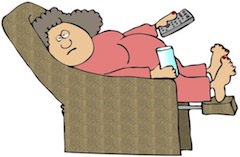A new favorite author of mine is Brene Brown. In her book, The Gifts of Imperfection, she explains how after working the 12 Steps for her drinking problem, she realized that alcohol was just one of the ways she compulsively sought to numb unwanted feelings.
 She writes, "For me, it wasn't just the dance halls, cold beer, and Marlboro Lights of my youth that got out of hand—it was banana bread, chips and queso, email, work, staying busy, incessant worrying, planning, perfectionism, and anything else that could dull those agonizing anxiety-fueled feelings of vulnerability."
She writes, "For me, it wasn't just the dance halls, cold beer, and Marlboro Lights of my youth that got out of hand—it was banana bread, chips and queso, email, work, staying busy, incessant worrying, planning, perfectionism, and anything else that could dull those agonizing anxiety-fueled feelings of vulnerability."
Today, Brown describes herself as a "take-the-edge-off-aholic."
"But there's no meeting for that," she adds.
And she's right. One drawback of the disease model of addiction is that it fails to address the millions of people who seek to escape their feelings in ways that are troublesome and costly, but diagnostically don't rise to the level of addiction.
Brown suggests that all of us practice numbing behaviors, on a sort of spectrum, with addiction being at one extreme. It's a helpful idea, if you ask me. Of course, not all flights of escape, indulgences or self-comforting tactics are harmful. But to the extent that they move us closer to serious addiction, nag at our consciences, depress us, or get in the way of our joy, they become problematic.
When I read this part of Brown's book, I immediately thought about my own numbing patterns. Just last night, Dave walked through the living room at about 8 o'clock and I cried out from the couch, "Save me! Help! I'm watching the dumbest ever reality TV show and I can't stop."
I'd tell you what show it was, but I'm honestly too embarrassed.
So how do we know if a particular compulsion is costing us more than its worth?
Brown suggests we ask: "Does our [habit] get in the way of our authenticity? Does it keep us from staying out of judgment and from feeling connected? Are we using it to hide or escape from the reality of our lives?"
Maybe, I have to answer. Sometimes.
I say that not because a reality show keeps me from being real with you. But because on occasion, I do regret it. I go to bed annoyed at myself and far from enriched by the experience. Plus, I know the cost of a thing includes the loss of the better thing we might have done—or ate or drank or spent time or money on—instead.
I don't mean to imply that we should never luxuriate in dumb TV, waste time on purpose, or allow ourselves a second bowl of ice cream. It's really about trying to live intentionally, don't you think? And whether such choices become a chronic pattern.
As Brown points out, the real problem with take-the-edge-off behaviors is that it's not possible to numb selectively. When life loses its sharp edges, you are spared some pain, but you probably won't feel sharp pangs of joy, either.
Once we're intent on seeking comfort over growth, escaping our problems over processing them, avoidance becomes a way of life. We still have all the same pain and problems, only now they're muffled, leaving us feeling vaguely sad and—yet again—in need of escape.
Having tried life both ways—numb but safe versus raw but vulnerable—my choice is clear today.
I don't want to miss a thing.
Where are you on a scale of numbness today?